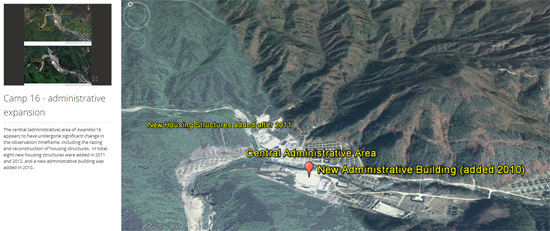
“After a night of ‘servicing’ the officials, the women had to die because the secret could not get out. This happens at most of the political prison camps.” – Mr. Lee, a former security official who has never spoken publicly before, in an interview with Amnesty International in November 2013
New satellite images further expose North Korea’s vast system of political prison camps – which I previously dubbed “The forgotten prisons” – whose very existence authorities continue to deny categorically. Contrary to heeding the growing international calls to close the camps, authorities continue to invest in the infrastructure of repression, perpetuating the systematic, widespread and grave violation of human rights.
This is, in a nutshell, the main finding of our new briefing published today. It contains analysis of Camp 16, the largest political prison camp in North Korea that, with a size of 560km2, is more than three times the size of Washington, D.C. Additional analysis is provided for Camp 15 at Yodok, which we have previously analyzed in 2011.
The satellite images show that both camps are active and well maintained, showing construction of additional housing in one case and a lot of economic activity in both camps. The images do not leave any doubt about the tight security and control that is imposed on the inmates, as characterized by perimeter fences, guard towers, few access gates and internal checkpoints.
The Human Tragedy
Satellite images can only tell us so much. Our briefing is thus accompanied by rare testimonies from a former inmate of Yodok (Camp 15) and a former security official who was involved in the administration of the camps in the 1980s and 1990s.
It is only these human stories that help us grasp the full dimensions of this tragedy. Ms. Kim Young-soon, the former inmate of Yodok, was sent to the camp because she was accused of “gossiping” about North Korea’s former leader Kim Jong-il. It gets worse: Her parents and son were sent with her to the camp, as they were deemed “guilty by association,” a central feature of the prison camp system.
In plain English, this is collective punishment. She ended up spending nine years in Yodok. In the end, she was the only one who got out – the rest of her family died in the camp.
Her story is emblematic of the horrors of North Korea’s prison camps, which are characterized by forced hard labor, food shortage and torture. All the eyewitnesses Amnesty International has interviewed over the last years have witnessed public executions in the camps.
We have shared our new findings with the recently established U.N. Commission of Inquiry, which will present its report next spring. The establishment of the Commission was an important step. Faced with the overwhelming evidence of abuse, it is now up to North Korean authorities to take appropriate steps. Independent, international human rights observers should be given access to the camps. Most importantly, all prisoners of conscience should be released immediately.
If you want to learn more about the forgotten prisoners, take a look at our resources:
- Inside North Korea: Camp 15 and 16 Exposed
- Briefing: New Satellite Images Show Continued Investment In the Infrastructure Of Repression
- Video Playlist: Stories from North Korea’s Prison Camps (co-curated with WITNESS)
- Interactive Map: North Korea’s Political Prison Camps
Imagery and analytics were commissioned by Amnesty International’s Science for Human Rights program from DigitalGlobe.
